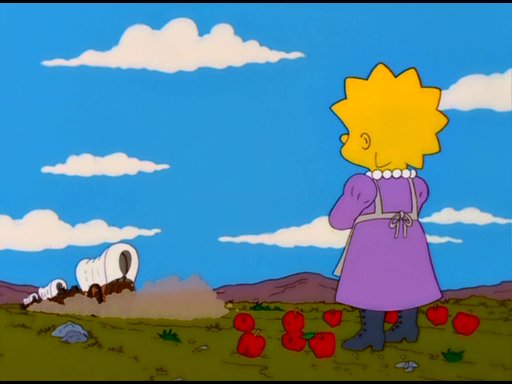The first segment is based on the mythological lumberjack Paul Bunyan, who carved Babe the Blue ox out of the Blue Mountains. The story first originated as a oral tale by North American loggers. The character first appeared in print form about a century ago, when mention of him was published in newspaper articles and such, before being used as a figurehead for advertising endeavors. The character grew in popularity up to the 60's and 70's, when he took on a distinguishable image. He became popular with children in particular; In 1958 Walt Disney Studios produced Paul Bunyan as an animated short musical. The full piece can be viewed here: https://www.youtube.com/watch?v=4CNtcDjywBA
The Disney version lasts over 15 minutes, so goes in to significantly more depth than the Simpsons telling. It comes from a more historically placed context, with a 'first person' story teller. This way it claims to be less fictitious than it actually is. The aesthetics are of key importance in this version. It also looks quite dated, employing the animation style typical of other 50's Disney pieces, with old-fashioned language used in the narration. The target audience seems like it would be young children.
In contrast, the Simpsons version relies more heavily on storytelling as opposed to aesthetic. Humour is used liberally, and carries the interest of the viewer. The animation style is more contemporary and practical rather than arty. It cuts out of a lot of the more mundane points of Paul Bunions life and focuses on the highlights. Paul is 'played' by Homer Simpsons, which combines the old and new in an interesting way. It takes liberties with the canon by adding new characters in to the story and humorous situations.
The second segment shows Lisa as Connie Appleseed, a female version of the American pioneer nurseryman Johnny Appleseed who introduced apple trees to large parts of Ohio,Indiana, and Illinois. He became an American legend while still alive. There have been numerous tellings and adaptations of his story, from plays, to guest appearances in books or tv. Again, in the Simpsons version, they adapt it very liberally for their own needs. Johnny becomes 'Connie' so that Lisa can 'play' the part of the main protagonist. Almost even more so than the first one, humour is used as a driving device in the narrative. The language used is quite modern, as the Simpsons would usually speak. The other characters are given parts in the tale as well.
"Tom and Huck" features Bart as Tom Sawyer and Nelson as Huckleberry Finn, both of whom are characters in Mark Twain's 1876 novel The Adventures of Tom Sawyer. Unlike the previous two, this is not based on a folktale; rather an actual novel. It is still interesting to see how the show adapts a popular American classic and makes it relevant and relateable to a modern TV audience. The writers make a point to use as much of the language and jargon in the books in this retelling, and the voice actors put on southern accents to better match the original location of the story. Because there is more definitive source material to base this part on than the previous few, it feels more true to the original and less liberties have been taken. This time, Tom sawyer is played by Bart, and Huckleberry Finn is played by Nelson. Humour features heavily yet again.
This episode is a neat example of how a cartoon can rehash a folktale in an entertaining way, making it appealing to modern audiences. In these examples, the essence of the tale is kept, while the characters and individual plot points can be changed dramatically.



